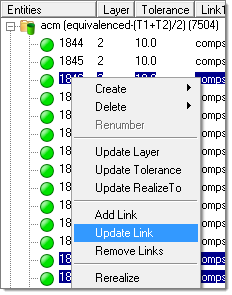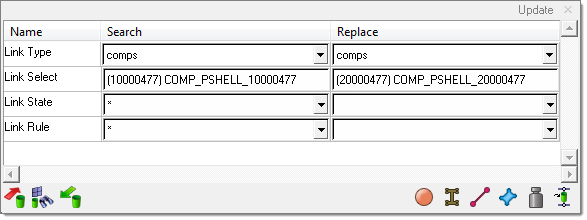Update Links |

|

|

|

|
|
Update Links |

|

|

|

|
Update Link is available in the Connector browser's right-click context menu.

Use Update Link to edit a link's attributes.

| 1. | Select the connectors from the browser for which one or more links need to be updated. |
The connectors can also be selected from the graphics area by using the Selector button in the action modes tool set. The connectors selected in the graphics area will be highlighted in the browser tree.
| 2. | Right-click onto one of the highlighted connectors in the entities column to open the full context menu and select the Update Link function. An Update Link dialog opens at the bottom of the Connector browser. All highlighted connectors will be affected by the subsequent update link action. |
| Note: | If the Update Link dialog is still open from a previous update link operation, all blue highlighted connectors will be affected when the update link function is performed again. |
The lines for Link State and Link Rule are grayed out by default in the Update Link dialog. When the extended information in the Connector Entity Browser configuration window is activated, these lines become active as well.
| 3. | Fill in the fields in the Search column. Due to this selection the links of the selected (highlighted) connectors are filtered down to the links which fit to all given search attributes. Only the remaining links are taken into account for the subsequent attribute replacement. |
| Note: | Not all of the search attributes have to be defined; an asterisk can be used. |
| 4. | Fill in the fields in the Replace column. All the remaining links will be updated with the attributes defined by these attributes. |
| Note: | Not all of the replace attributes have to be defined; an asterisk can be used. The prior attributes are maintained. |
| 5. | Click Update to acknowledge and execute the operation. |
| Note: | Not every combination of search and replace attributes are valid. For example, it is not possible to select the asterisk for the Link Select field in the Search column and replace it with a concrete link. This helps to prevent global creation of unwanted modifications. |
Update link operations are frequently used for:
If a part replacement needs to be performed, the browser provides quick tools to update one or more connectors with the link referencing the new redesigned part. The following sections present steps to edit and update the link rule and the link state attributes as well as the part replacement.
The link rule defines how a connector treats an entity added as a link. Adding a link with the ID or name rule forces the connector to retain the link’s ID or name even if that link entity no longer exists in the database. Adding a link with the at fe-realize rule ensures that each time a connector is realized the closest entity of the correct type is found and connected.
To update link rules
The connectors can also be selected from graphics by using the Selector button
ExampleThe following screenshots illustrate a link rule modification.
The starting link rule is underlined in red. Note that use-id is specified as the replacement link rule. After performing the modification, the current link rule has changed for the selected links:
The newly replaced link rule is underlined in blue. |
The link state defines if the weld created during connector realization connects to geometry or mesh on the link. This is applicable to only components and surfaces entities that can contain geometry and/or mesh information. To update link states
The connectors can also be selected from graphics by using the Selector button
ExampleThe following screenshots illustrate a link state modification.
The starting link state is underlined in red. Note that use-id is specified as the replacement link state. After performing the modification, the current link state has changed for the selected links:
The newly replaced link state is underlined in blue |